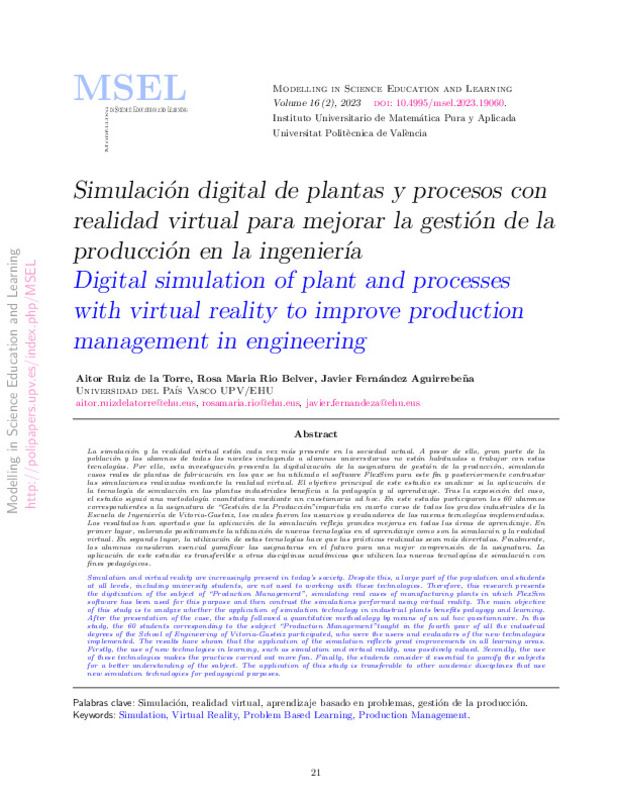Abulrub, A. H. G., Attridge, A. N., & Williams, M. A. (2011). Virtual reality in engineering education: The future of creative learning. 2011 IEEE Global Engineering Education Conference, EDUCON 2011, 751-757. https://doi.org/10.1109/EDUCON.2011.5773223
Chen, J., Kolmos, A., & Du, X. (2021). Forms of implementation and challenges of PBL in engineering education: a review of literature. European Journal of Engineering Education, 46(1), 90-115. https://doi.org/10.1080/03043797.2020.1718615
Chernyakov, M. K., Chernyakova, M. M., & Ch Akberov, K. (2018). Simulation Design of Manufacturing Processes and Production Systems. https://doi.org/10.2991/aime-18.2018.24
[+]
Abulrub, A. H. G., Attridge, A. N., & Williams, M. A. (2011). Virtual reality in engineering education: The future of creative learning. 2011 IEEE Global Engineering Education Conference, EDUCON 2011, 751-757. https://doi.org/10.1109/EDUCON.2011.5773223
Chen, J., Kolmos, A., & Du, X. (2021). Forms of implementation and challenges of PBL in engineering education: a review of literature. European Journal of Engineering Education, 46(1), 90-115. https://doi.org/10.1080/03043797.2020.1718615
Chernyakov, M. K., Chernyakova, M. M., & Ch Akberov, K. (2018). Simulation Design of Manufacturing Processes and Production Systems. https://doi.org/10.2991/aime-18.2018.24
Chou, C.-H. (1998). The effectiveness of using multimedia computer simulations coupled with social constructivist pedagogy in a college introductory physics classroom. https://search.proquest.com/openview/0c58850dd8eda165694c65a379822803/1?pq-origsite=gscholar&cbl=18750&diss=y
Cózar-Gutiérrez, R., & Sáez-López, J. M. (2016). Game-based learning and gamification in initial teacher training in the social sciences: an experiment with MinecraftEdu. International Journal of Educational Technology in Higher Education 2016 13:1, 13(1), 1-11. https://doi.org/10.1186/S41239-016-0003-4
European Commission, Directorate-General for Communications Networks, C. and T. (2019). Digital skills : new professions, new educational methods, new jobs : final report. https://doi.org/10.2759/36058
He, B., & Bai, K. J. (2021). Digital twin-based sustainable intelligent manufacturing: a review. Advances in Manufacturing, 9(1), 1-21. https://doi.org/10.1007/s40436-020-00302-5
Helsel, S. (1992). Virtual Reality and Education on JSTOR. https://www.jstor.org/stable/44425644
Kellner, M. I., Madachy, R. J., & Raffo, D. M. (1999). Software process simulation modeling: Why? What? How? Journal of Systems and Software, 46(2-3), 91-105. https://doi.org/10.1016/S0164-1212(99)00003-5
Kopcha, T. J. (2012). Teachers' perceptions of the barriers to technology integration and practices with technology under situated professional development. Computers and Education, 59(4), 1109-1121. https://doi.org/10.1016/j.compedu.2012.05.014
Mercader, C. (2020). Explanatory model of barriers to integration of digital technologies in higher education institutions. Education and Information Technologies, 25(6), 5133-5147. https://doi.org/10.1007/s10639-020-10222-3
Mercader, C., & Sallán, J. G. (2017). ¿Cómo utiliza el profesorado universitario las tecnologías digitales en sus aulas? REDU. Revista de Docencia Universitaria, 15(2), 257-274. https://doi.org/10.4995/redu.2017.7635
Merchant, Z., Goetz, E. T., Cifuentes, L., Keeney-Kennicutt, W., & Davis, T. J. (2014). Effectiveness of virtual reality-based instruction on students' learning outcomes in K-12 and higher education: A meta-analysis. Computers and Education, 70, 29-40. https://doi.org/10.1016/j.compedu.2013.07.033
Pantelidis, V. S. (2010). Reasons to Use Virtual Reality in Education and Training Courses and a Model to Determine When to Use Virtual Reality. Themes in Science and Technology Education, 2(1-2), 59-70. http://earthlab.uoi.gr/ojs/theste/index.php/theste/article/view/22
Pottle, J. (2019). Virtual reality and the transformation of medical education. Future Healthcare Journal, 6(3), 181. https://doi.org/10.7861/fhj.2019-0036
Sauvé, L., Renaud, L., Kaufman, D., & Marquis, J. S. (2007). Distinguishing between games and simulations: A systematic review. Educational Technology and Society, 10(3), 247-256. https://www.jstor.org/stable/jeductechsoci.10.3.247
Söderström, T., Häll, L., … T. N.-S. &, & 2014, undefined. (2014). Computer Simulation Training in Health Care Education: Fuelling Reflection-in-Action? Journals.Sagepub.Com, 45(6), 805-828. https://doi.org/10.1177/1046878115574027
Turner, C. J., Hutabarat, W., Oyekan, J., & Tiwari, A. (2016). Discrete Event Simulation and Virtual Reality Use in Industry: New Opportunities and Future Trends. IEEE Transactions on Human-Machine Systems, 46(6), 882-894. https://doi.org/10.1109/THMS.2016.2596099
Vlachopoulos, D., & Makri, A. (2017). The effect of games and simulations on higher education: a systematic literature review. International Journal of Educational Technology in Higher Education, 14(1), 1-33. https://doi.org/10.1186/s41239-017-0062-1
Wollschlaeger, M., Sauter, T., & Jasperneite, J. (2017). The future of industrial communication: Automation networks in the era of the internet of things and industry 4.0. IEEE Industrial Electronics Magazine, 11(1), 17-27. https://doi.org/10.1109/MIE.2017.2649104
Zacharia, Z. C. (2003). Using interactive simulations to enhance students' explanations regarding physical phenomena. In lekythos.library.ucy.ac.cy. http://lekythos.library.ucy.ac.cy/handle/10797/14705
[-]









